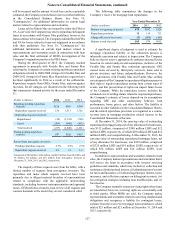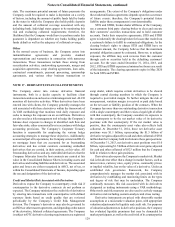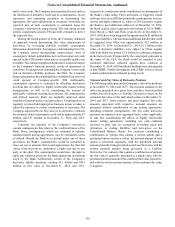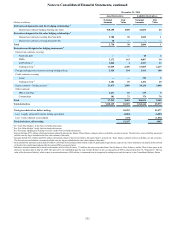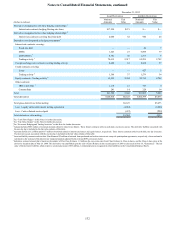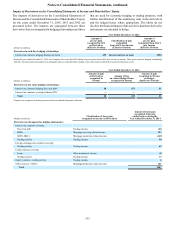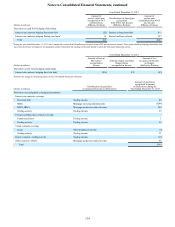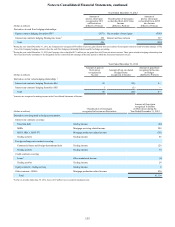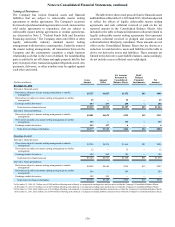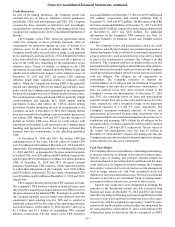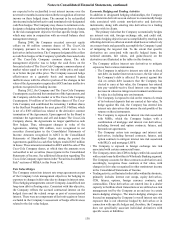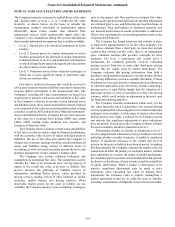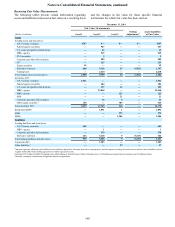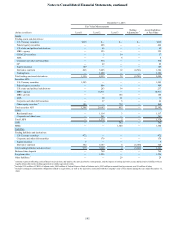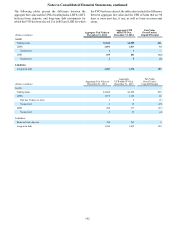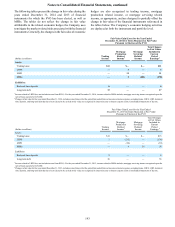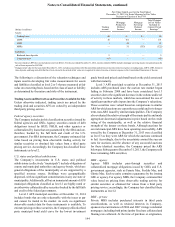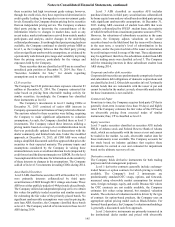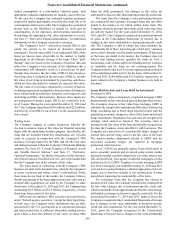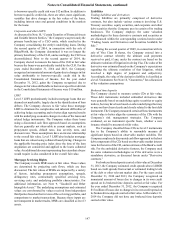SunTrust 2014 Annual Report Download - page 160
Download and view the complete annual report
Please find page 160 of the 2014 SunTrust annual report below. You can navigate through the pages in the report by either clicking on the pages listed below, or by using the keyword search tool below to find specific information within the annual report.Notes to Consolidated Financial Statements, continued
137
Credit Derivatives
As part of its trading businesses, the Company enters into
contracts that are, in form or substance, written guarantees:
specifically, CDS, risk participations, and TRS. The Company
accounts for these contracts as derivatives and, accordingly,
recognizes these contracts at fair value, with changes in fair value
recognized in trading income in the Consolidated Statements of
Income.
The Company writes CDS, which are agreements under
which the Company receives premium payments from its
counterparty for protection against an event of default of a
reference asset. In the event of default under the CDS, the
Company would either net cash settle or make a cash payment
to its counterparty and take delivery of the defaulted reference
asset, from which the Company may recover all, a portion, or
none of the credit loss, depending on the performance of the
reference asset. Events of default, as defined in the CDS
agreements, are generally triggered upon the failure to pay and
similar events related to the issuer(s) of the reference asset. At
December 31, 2014 and 2013, all written CDS contracts
reference single name corporate credits or corporate credit
indices. When the Company has written CDS, it has generally
entered into offsetting CDS for the underlying reference asset,
under which the Company paid a premium to its counterparty
for protection against an event of default on the reference asset.
The counterparties to these purchased CDS are generally of high
creditworthiness and typically have ISDA master netting
agreements in place that subject the CDS to master netting
provisions, thereby mitigating the risk of non-payment to the
Company. As such, at December 31, 2014, the Company did not
have any material risk of making a non-recoverable payment on
any written CDS. During 2014 and 2013, the only instances of
default on written CDS were driven by credit indices with
constituent credit default. In all cases where the Company made
resulting cash payments to settle, the Company collected like
amounts from the counterparties to the offsetting purchased
CDS.
At December 31, 2014 and 2013, the written CDS had
remaining terms of four years. The fair values of written CDS
were $1 million and $3 million at December 31, 2014 and 2013,
respectively. The maximum guarantees outstanding at December
31, 2014 and 2013, as measured by the gross notional amounts
of written CDS, were $20 million and $60 million, respectively,
which represent the termination or collapse of a mirror purchase
CDS. At December 31, 2014 and 2013, the gross notional
amounts of purchased CDS contracts, which represent benefits
to, rather than obligations of, the Company, were $190 million
and $70 million, respectively. The fair values of purchased CDS
were $5 million and $3 million at December 31, 2014 and 2013,
respectively.
The Company has also entered into TRS contracts on loans.
The Company’s TRS business consists of matched trades, such
that when the Company pays depreciation on one TRS, it receives
the same amount on the matched TRS. To mitigate its credit risk,
the Company typically receives initial cash collateral from the
counterparty upon entering into the TRS and is entitled to
additional collateral if the fair value of the underlying reference
assets deteriorates. At December 31, 2014 and 2013, there were
$2.3 billion and $1.5 billion of outstanding TRS notional
balances, respectively. The fair values of the TRS derivative
assets and liabilities at December 31, 2014 were $19 million and
$14 million, respectively, and related collateral held at
December 31, 2014 was $373 million. The fair values of the TRS
derivative assets and liabilities at December 31, 2013 were $35
million and $31 million, respectively, and related collateral held
at December 31, 2013 was $228 million. For additional
information on the Company's TRS contracts, see Note 10,
"Certain Transfers of Financial Assets and Variable Interest
Entities."
The Company writes risk participations, which are credit
derivatives, whereby the Company has guaranteed payment to a
dealer counterparty in the event that the counterparty experiences
a loss on a derivative, such as an interest rate swap, due to a failure
to pay by the counterparty’s customer (the “obligor”) on that
derivative. The Company monitors its payment risk on its risk
participations by monitoring the creditworthiness of the obligors,
which is based on the normal credit review process the Company
would have performed had it entered into the derivatives directly
with the obligors. The obligors are all corporations or
partnerships. The Company continues to monitor the
creditworthiness of its obligors and the likelihood of payment
could change at any time due to unforeseen circumstances. To
date, no material losses have been incurred related to the
Company’s written risk participations. At December 31, 2014
and 2013, the remaining terms on these risk participations
generally ranged from one to nine years and from one to twelve
years, respectively, with a weighted average on the maximum
estimated exposure of 5.2 and 6.9 years, respectively. The
Company’s maximum estimated exposure to written risk
participations, as measured by projecting a maximum value of
the guaranteed derivative instruments based on interest rate curve
simulations and assuming 100% default by all obligors on the
maximum values, was approximately $31 million and $33 million
at December 31, 2014 and 2013, respectively. The fair values of
the written risk participations were less than $1 million at
December 31, 2014 and 2013. As part of its trading activities, the
Company may enter into purchased risk participations to mitigate
credit exposure to a derivative counterparty.
Cash Flow Hedges
The Company utilizes a comprehensive risk management strategy
to monitor sensitivity of earnings to movements in interest rates.
Specific types of funding and principal amounts hedged are
determined based on prevailing market conditions and the shape
of the yield curve. In conjunction with this strategy, the Company
may employ various interest rate derivatives as risk management
tools to hedge interest rate risk from recognized assets and
liabilities or from forecasted transactions. The terms and notional
amounts of derivatives are determined based on management’s
assessment of future interest rates, as well as other factors.
Interest rate swaps have been designated as hedging the
exposure to the benchmark interest rate risk associated with
floating rate loans. At December 31, 2014 and 2013, the hedge
maturities for hedges of floating rate loans ranged from less than
one year to four years and from less than one year to five years,
respectively, with the weighted average being 1.9 and 2.0 years,
respectively. Ineffectiveness on these hedges was immaterial for
all years presented. At December 31, 2014, $203 million of the
deferred net gains on derivatives that are recognized in AOCI


